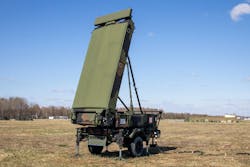Northrop Grumman pushes ahead to convert Marine Corps G/ATOR radar to gallium nitride GaN) to enhance SWaP
QUANTICO MARINE BASE, Va. – U.S. Marine Corps surveillance experts are pushing forward with a project to upgrade mobile land-based radar systems from gallium arsenide (GaAs) to gallium nitride (GaN) technology.
Officials of the Marine Corps Systems Command at Quantico Marine Base, Va., announced a $17 million order Thursday to the Northrop Grumman Corp. Mission Systems segment in Linthicum, Md., for three Ground/Air Task Oriented Radar (G/ATOR) gallium arsenide technology to gallium nitride technology retrofit kits.
G/ATOR, which was developed originally with GaAs RF and microwave integrated circuit technology, is a radar system designed to protect Marines on attack beaches from rockets, artillery, mortars, cruise missiles, unmanned aerial vehicles (UAVs), and other low observables.
G/ATOR is an expeditionary, three-dimensional, short-to-medium-range, multi-role radar system designed to detect low-observable targets with low radar cross sections such as rockets, artillery, mortars, cruise missiles, and UAVs. Marine Corps leaders are developing and fielding G/ATOR in three blocks for use by the Marine Air Ground Task Force across the range of military operations, officials say.
Related: GaN X-band front-end modules for radar and similar uses introduced by Qorvo
Northrop Grumman began converting G/ATOR radar systems from GaAs to GaN technology in 2015 to make the system more effective, and to reduce its costs, and reduce its weight and power consumption.
Substituting gallium nitride electronic components for older gallium arsenide technology will help Northrop Grumman and the Marine Corps reduce the mass of the G/ATOR system without compromising its performance, officials say.
Reducing size, weight, and power consumption (SWaP) especially is important for the G/ATOR system because Marine Corps leaders plan to use the system on attack beaches to help defend Marine expeditionary forces from low-observable threats. The system must be sufficiently small and lightweight to accompany Marines in their initial land attacks.
Northrop Grumman built G/ATOR for short-range air-defense (SHORAD) and tactical air operations Center (TAOC) air surveillance missions, including identification friend-or-foe (IFF). The increment I design was to provide for growth to all following increments without equipment re-design and provide an open architecture to enable upgrades with following increments.
Related: Mouser offers Qorvo QPD GaN transistors for military radar and electronic warfare (EW)
The G/ATOR program was to showcase new component technologies, including the then-new VPX embedded computing fast switch-fabric interconnect. As part of the G/ATOR program's first increment, Northrop Grumman awarded a $4.3 million contract in 2008 to the Curtiss-Wright Corp. Defense Solutions segment in Ashburn, Va., for VPX-based embedded computers for radar signal processing, to be delivered by 2010.
The Ground Weapons Locating Radar (GWLR) portion of G/ATOR uses active electronically scanned array (AESA) radar technology to provide several different radar missions and adapt automatically to changing battlefield conditions.
On this order Northrop Grumman will do the work in Linthicum, Md., and should be finished by February 2026. The order increases the cumulative face value of the contract to $997.3 million. For more information contact Northrop Grumman Mission Systems online at www.northropgrumman.com.
About the Author
John Keller
Editor-in-Chief
John Keller is the Editor-in-Chief, Military & Aerospace Electronics Magazine--provides extensive coverage and analysis of enabling electronics and optoelectronic technologies in military, space and commercial aviation applications. John has been a member of the Military & Aerospace Electronics staff since 1989 and chief editor since 1995.
